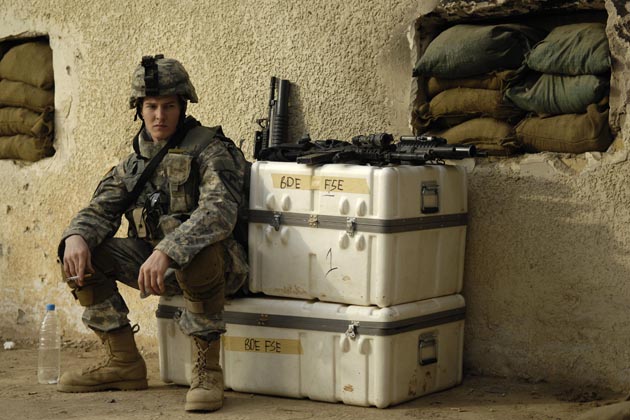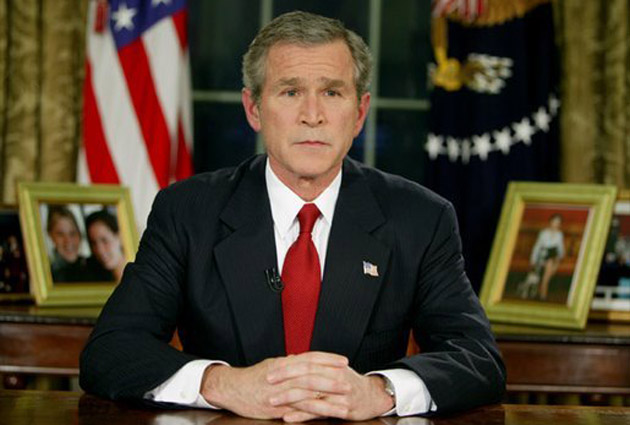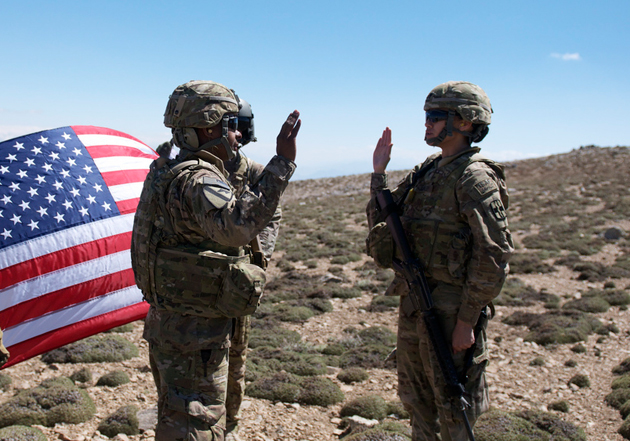
<a href="http://www.defense.gov/photos/newsphoto.aspx?newsphotoid=8939">Sgt. Stacy L. Pearsall</a>/Department of Defense
This story first appeared on the TomDispatch website.
I was one nightmare short of PTSD.
It didn’t take much, that’s what surprised me. No battles. No dead bodies. I spent just three and a half weeks as a contractor in Iraq, when the war there was at its height, rarely leaving the security of American military bases.
For several years now, Americans have become increasingly aware that a large number of veterans have gotten post-traumatic stress disorder (PTSD) in Iraq and Afghanistan. Studies estimate that at least 1 in 5 returning vets—possibly as many as 1 in 3—have it. Less notice has been given to the huge numbers of veterans who suffer some PTSD symptoms but not quite enough to be diagnosed as having the disorder. Civilian employees of the US government, contractors, and of course the inhabitants of the countries caught up in America’s wars have gotten even less notice.
The thing is: It doesn’t take much to develop the symptoms of PTSD. Our idea of what used to be called “shell shock” tends to be limited to terrible battles, not just the daily stress of living in a war zone or surviving a couple of close calls.
This is a story of how little it can take. I hardly saw a thing.
I.
My first day in Iraq ended with an explosion.
I had just made it “in theater,” as they said, with a plane-load’s worth of contractors coming for this or that bit of danger pay. I was 32 years old, an analyst at the RAND Corporation, a nervous, excited, frightened policy wonk. I had executed my first will.
People would ask me, Why go? For typical reasons: Adventure. Hazard pay. I was single. No kids, no lawn to mow. I thought it would be cool. I’d get to pal around with the troops and fly in helicopters and wear body armor. I’d get to learn more about the whole war thing, which had always obsessed me, as it does so many Americans. And if I were lucky, I might even catch a glimpse of how much more idiotic the Iraq War was than I already assumed. I had never bought into it, but that didn’t mean I wasn’t eager to be there.
And then there was the work itself. My project fascinated me: to figure out what exactly was going on at a weird camp in Diyala Province where American troops were sort of detaining, sort of babysitting an Iranian cult group that was then on our list of foreign terrorist organizations. To a lawyer and policy wonk, a man whose boyhood had been consumed by all things military, the combo was irresistible.
***
That first night, after we finished dinner at the DFAC, the Dining Facility, my supervisor and I drove our rental Ford Explorer through the concrete T-wall jungle of the curiously named Victory Base Complex, the giant American encampment at the edge of Baghdad International Airport. As we arrived at the shipping container that was to be my new temporary home: explosions. Then a piercing cry from loudspeakers in the distance: INCOMING! INCOMING! INCOMING!
The next day I’d learn that those explosions had blown up several people in front of the chow hall, right where we had exited just minutes earlier.
It was October 2007, during the Muslim holy month of Ramadan, and General David Petraeus was the rising star of the moment with his “surge” strategy. Mortar and rocket attacks, which had once been repeated daily occurrences, were now plummeting. Gunfire, though, still prickitypricked the night, every night, out in the “Red Zone,” that wild yonder of the country beyond those T-walls. It sounded like disorganized fireworks, only without the happy spectacle.
When the mortar and rocket attacks did come, it was usually early morning, between 5:45 and 6:00 a.m. I called it the Insurgent Alarm Clock. Afternoons featured “controlled dets.” A boom here or there as soldiers detonated duds, blew up UXO (unexploded ordnance).
The nights whirred with helicopters. Blackhawks patrolled the perimeter in pairs. Even on the ground they kept their rotors spinning for quick liftoffs, and there was a landing zone near my bed. But that didn’t keep me from sleeping once I got some earplugs. Nor could the snores of the seven other men in the corrugated-metal containerized housing unit keep me awake. The tension was too exhausting.
II.
The worst day started with an explosion.
Shockwaves rattled me awake. That was a first. Usually I just heard the insurgent alarm clock; I didn’t feel it.
Now, it was stone quiet in the shipping container. No more grunts from sleeping men. I craned my neck. In the low light cast by the lamp of an early riser tying his running shoes, I could see that we were awake to a man, frozen like rabbits, ears perked, waiting for the next bass rumble.
You see, insurgents wouldn’t attack the world’s most powerful military with just one shot. They’d lob a bunch of mortars or rockets over the concrete, and, to increase their odds of actually hitting something, they wouldn’t aim at just one place.
Kaboom.
Closer. My heart pounded, but what to do with the knowledge that the attack was coming our way? I could’ve made a dash for one of the concrete bomb shelters that dotted the base, but there weren’t any nearby. Besides, no one thought they did much good. They were open on two sides and people got hurt running to them.
No big deal, I thought. It was well known that the insurgents’ aim sucked.
KaBOOM.
Even closer. I felt the compression in my chest. I couldn’t believe that, just the previous day, I had been running the numbers to see whether it was worth extending my stay to get a bump in danger pay.
At least their aim did suck. The vastness of Camp Victory was so full of manmade lakes, dry marshes, and empty expanses of dirt, brush, and asphalt that the insurgents rarely hit anything. We were, however, close to one obvious target, the big palace that the US military had colonized for its headquarters.
KaBOOM!
The trailer shook hard, and someone yelled, “Hit the deck!” I was already rolling. I dropped to the hard cold floor and slid under the bed. The guy from the top bunk squished in beside me, his feet in my face.
Officially scared now. Out in the distance, the weirdly thin, flat voice of the warning horn finally woke up: INCOMING! INCOMING! INCOMING!
And my brain was shrieking, too. What protection would these flimsy walls and mattresses provide against rockets and mortars? I should’ve run for a concrete bunker. I had missed my chance.
Someone had said that lying flat kept you safe from the blast angle, so I tried to mimic a pancake.
KABOOM!
Furniture-rattlingly close.
My adrenal glands started pumping faster, flooding my blood and … time slowed … I felt a sort of clarity. Not moral clarity or wisdom, but sensory clarity—a readiness to act, to survive. So this was mortal fear. Not very nice to meet you.
KA–BOOOOOM!
They’d found us. It felt like the explosion had occurred right outside the door, like lightning striking the neighbors. Any closer and we’d be dead.
Somehow, we went even flatter. All I could do was lie there and hope that the next one wouldn’t get us, hope that there weren’t people out there right now with twisted metal driven into their flesh.
We lay there, waiting… waiting… and then… nothing.
Silence.
No screams. That was good, right? And then, in the distance, the horn spoke: ALL CLEAR. ALL CLEAR.
Long seconds passed. Doors creaked open on neighboring trailers, while we rolled out from under our beds, muscles cramping. I pulled on a shirt and stepped into the light. All along the row of containers, men in shorts or underwear were peeking out. Despite their tans and youth and professional toughness, they looked pale, drained, scared.
Little was said. That was close. That sucked. Eyes followed eyes to the end of our little trailer park. Just past a row of trees a black plume of smoke mushroomed into the sky. Someone said there was a generator over there, maybe 25 yards away, musta got hit.
That’s when my jitters started.
III.
Fast forward to December. I’m back home, talking to a colleague in his office. For some reason I’ve decided he’s the one I’ll tell about my dreams. I need to share. They’re haunting me. Incredibly violent dreams. Night after night.
They aren’t even remotely similar to anything in my normal experience. Sure, I had had the occasional violent nightmare, but usually I was on the receiving end, running in fear to escape some cruel threat. In these I’m the one doing violence.
 In one, I’m a terrorist. I hijack a commercial airplane, strangle a female flight attendant with my bare hands. My own hands. I wake up frightened of myself, for myself.
In one, I’m a terrorist. I hijack a commercial airplane, strangle a female flight attendant with my bare hands. My own hands. I wake up frightened of myself, for myself.
My friend is a psychologist and statistician. “You know I’m studying PTSD?” he says. He’s been working on a big research project on post-traumatic stress disorder and traumatic brain injuries in veterans back from Iraq and Afghanistan.
He pulls a huge textbook off the shelf above his computer, lets it fall open on his desk and starts flipping pages. It’s the Diagnostic and Statistical Manual-IV, published by the American Psychiatric Association. “Recurrent distressing dreams,” he reads aloud.
I walk around the desk, look over his shoulder. There’s a long checklist of symptoms. Suffer enough of them and you’re diagnosable with PTSD.
The person experienced, witnessed, or was confronted with an event or events that involved actual or threatened death or serious injury, or a threat to the physical integrity of self or others.
Yep.
The person’s response involved intense fear, helplessness, or horror.
Yep.
We keep looking at the symptoms. There are many. You don’t have to have all of them to get diagnosed. A few jump out at me.
Persistent avoidance of stimuli associated with the trauma and numbing of general responsiveness (not present before the trauma)… [Shown by:] Efforts to avoid thoughts, feelings, or conversations associated with the trauma.
Efforts to avoid activities, places, or people that arouse recollections of the trauma.
Feeling of detachment or estrangement from others.
All are familiar.
In the past month, I had come to a sudden appreciation of the war veteran’s reticence. Everyone wanted to ask me about my experiences in Iraq: What was it like there? Something kept me from talking. That bad morning, the pain and displacement of the war on everyone involved, the constant tension. I couldn’t bring myself to speak about it. It was too much to face, too much to explain. And I had seen next to nothing.
To avoid being rude, I had a pat response memorized: “I learned three things in Iraq. Military toys really are cool. Our troops are even more impressive than I had thought they were. And war is much, much worse than I had ever imagined.”
For months, that’s all I was willing to say.
And here’s another thing from that manual I recognized: Persistent symptoms of increased arousal (not present before the trauma)… [such as an] exaggerated startle response.
Oh yeah. Definitely.
On my very first day out of Iraq, weirdly laced with survivor’s guilt, I checked into a hotel in Amman, Jordan, and fell onto the bed, beyond exhausted. Down the hall a door slammed shut and I panicked. I thought it was gunfire.
On my way home, I stopped in London. With a friend, I visited the Imperial War Museum to catch an exhibit on war propaganda. Half an hour of looking at posters demonizing enemy peoples turned out to be enough for me, and so I wandered into a World War I exhibit, a diorama of one of that war’s many murderous charges. To make the viewing experience more interesting, the designers had darkened the room and added an occasional flash of light and a soundtrack of kerblammy explosions.
I was unimpressed. It was just noise. Real explosions rattle your chest.
When my buddy found me, he was horrified. I had gone pale. He should have known better, he insisted, than to let me come here so soon.
***
“Duration of the disturbance,” says the manual, “is more than 1 month.”
I look at my colleague’s wall calendar. It’s 29 days since I left Iraq and the nightmares have stopped, so I don’t have PTSD. Or at least I’m not diagnosable. I feel a wash of relief.
Later, when the study he’s working on is released, I learn that, as of 2007, some 300,000 veterans are already diagnosable with PTSD, and it’s obvious that the wars in Iraq and Afghanistan aren’t about to end any time soon. How many more, I wonder, will be suffering from PTSD before it’s all over? How many will have some of the symptoms, but not enough to qualify for care? And what about civilians and contractors? What about Iraqis? Was anyone counting their incidence of sub-diagnosable symptoms?
Back in my office, I find the checklist online and stare at it. I berate myself. I should’ve sought care. No, I think, go easy. After all, I hadn’t recognized the symptoms. And even if I had, in Iraq I had no unit for support, no routine, no institutional refuge. Military culture is clear: suck it up, get tough, be a man. And I had kept it all from my family. I wanted them to sleep at night.
Worst of all, I hadn’t really seen anything of war. In that morning’s attack, no one got hurt, at least not physically. None of us had been out shooting people or dodging bullets. Still, how could it not be a big deal? Just because so many things were far bigger deals didn’t turn that morning into nothing.
People said they got used to it. I didn’t believe them.
***
I thought I was done with the symptoms, but I was wrong. Some lingered for months, even years. The startle response, for instance. Doors, horns, any sudden noise and adrenaline would fire off, unwanted.
By the end of the following year, I was convinced it was finally over—until, on the Fourth of July 2009, my girlfriend (now wife) and I went to a party and stood on a balcony to watch the usual fireworks. At the first explosion, I felt the panic return, and I had to retreat inside.
For commiseration, I phoned a friend who had spent a year in Iraq with the State Department. When I had seen him in the Green Zone back in 2007, he had already aged frighteningly, his hair newly flecked with gray. He, too, was watching fireworks, and he, too, was experiencing the same sense of panic. Only he was on an open boat in the middle of a lake with nowhere to hide.
IV.
Last month was the 10th anniversary of our invasion of Iraq and already that war is fading out of memory, replaced by the latest rumblings of violence with North Korea and continued saber rattling over Syria and Iran. People who promote new wars have a tendency to give only a cursory nod to the costs of war itself. We hear the occasional mention of Iraqi civilian deaths (usually citing some preposterous lowball estimate as if it were established fact) or a nod to the way a whole bunch of soldiers got PTSD in Iraq and Afghanistan. But how often do we hear real consideration of the human costs of war, or even much in the way of the long-term financial and economic costs of treating thousands and thousands of people harmed by our wars?
Those costs are very real. The Veterans Administration reports that it has diagnosed 247,243 veterans who served in Iraq and Afghanistan with PTSD, or 30% of its patients from those two wars. That doesn’t even touch on the huge number of veterans who haven’t sought care yet, or are waiting for an evaluation, or suffer some symptoms but aren’t quite diagnosable. Young veterans of the wars are unemployed at almost twice the rate of their peers. Suicides now outpace combat deaths as the Afghan War slows down.
An understaffed VA and the military are, for their part, at least trying to address the surge of PTSD among the troops, however ineptly. (The average wait time for the backlog of almost one million compensation claims is almost a year and appeals on the 46% of rejected claims take far longer). But what about civilian employees? As of 2007, the American Foreign Service Association estimated that approximately 40% of State Department diplomats who served in combat zones suffered some symptoms of PTSD.
And what about contractors? I know I wasn’t alone, but there isn’t much information out there. One small study of in-country contract employees at the major Pentagon contractor DynCorp found that 24% showed signs of PTSD or depression upon returning home. This is no small issue: there have been more contractors than troops in Afghanistan for much of that war.
And what about the people who actually live in the war-torn country, who don’t get to escape the war and go back to a peaceful home at the end of a deployment? Civilians are the great victims of modern war. In Afghanistan, the Centers for Disease Control and Prevention found that 42% of Afghans suffered from PTSD and 68% showed signs of major depression—and that, mind you, was back in 2002. The country’s health minister estimated in 2010 that 60% of Afghans suffer from mental-health problems. Beyond prayer, that country has close to zero services to help its people. Washington’s “nation-builders” tend to forget about basic things like this.
These are not just short-term human costs that will fade away as my PTSD symptoms did. I was a lucky one, briefly in theater and mostly sheltered. For some, the trauma lingers for decades. Today, an American veteran of any war takes his or her own life every 65 minutes. Veterans account for 1% of the overall population but 22.2% of the nation’s suicides, and the majority of those happen after age 50. In other words, as with the debt we used to fund the wars, we will pay—and shirk—these costs for many years to come.
It doesn’t take much to develop PTSD symptoms. The folks clamoring for new wars should remember that. Those defending the Obama administration’s drone-missile targeted assassination campaigns should keep that in mind, too. Admittedly, robots don’t develop the disorder, but drone pilots hundreds or thousands of miles away are at risk, and civilians who live where drones regularly hover and strike are already suffering from PTSD. For me, it only took a few explosions.
Civilian officials who beat their chests about making “hard choices” and “tough decisions” should listen up. They have no idea how many eggs they are breaking to make their proverbial omelets. Would it matter if they did? I suspect that it would, if they recognized that people have soft shells, if they considered how war harms most everyone it touches, if they spent even a moment laying their cold assumptions aside and empathizing with war’s victims—their victims—both foreign and domestic.
I have a mental image of them relaxing in their homes, watching a movie. On the flat screen, scenes of war flash by, inspiring them, giving them ideas. I used to love war movies, too. Almost six years later, I still can’t watch them. The old panic sets in and I have to walk away.
Jeremiah Goulka, a TomDispatch regular and former RAND Corporation analyst, writes about American politics and culture, focusing on security, race, and the Republican Party. You can follow him on Twitter @jeremiahgoulka or contact him through his website jeremiahgoulka.com.
Follow TomDispatch on Twitter and join us on Facebook or Tumblr. Check out the newest Dispatch book, Nick Turse’s The Changing Face of Empire: Special Ops, Drones, Proxy Fighters, Secret Bases, and Cyberwarfare. To stay on top of important articles like these, sign up to receive the latest updates from TomDispatch.com here.
















